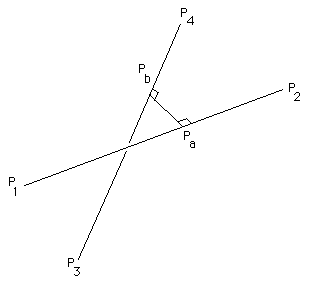In addition to Bobs answer:
I find on testing that the intersection() function as written solves half the original problem, which was an algorithm to find the point of intersection of two 3D line segments.
Assuming the lines are coplanar, there are 5 possible outcomes to this question:
The line segments are parallel, so they don't intersect, or,
The line segments aren't parallel, and the infinite length lines they lie upon do intersect, but the intersection point is not within the bounds of either line segment, or,
The lines intersect and the intersection point is within the bounds of line a but not line b, or,
The lines intersect and the intersection point is within the bounds of line b but not line a, or,
The lines intersect and the intersection point is within the bounds of both line segments.
Bob's intersection() function returns true when the lines intersect and the point of intersection is within the bounds of line a, but returns false if the lines intersect and the point of intersection is within the bounds of only line b.
But if you call intersect() twice, first with lines a then b and then a second time with lines b and a (first and second params swapped), then if both calls return true, then the intersect is contained within both line segments (case 5). If both calls return false, then neither line segment contains the intersect (case 2). If only one of the calls returns true, then the segment passed as the first parameter on that call contains the point of intersection (cases 3 or 4).
Also, if the return from the call to norm2(cross(da,db)) equals 0.0, then the line segments are parallel (case 1).
The other thing I noted in testing is that with fixed precision floating point numbers of the kind code is often implemented with, it can be quite unusual for dot(dc, cross(da,db)) to return 0.0, so returning false when its not the case might not be what you want. You might want to introduce a threshold below which the code continues to execute rather than return false. This indicates the line segments are skew in 3D, but depending on your application you might want to tolerate a small amount of skew.
The final thing I noticed was this statement in Bill's code:
ip = a.first + da * Coord(s,s,s);
That da * Coord(s,s,s) looks to be a vector times vector multiply. When I replaced it with a scalar multiple of da * s, I found it worked fine.
But in any case, many thanks to Bob. He figured out the hard part.


zplanes. If you project them to the xy planes then they will appear to be intersecting, even though they are not. – Gasparoaandbmust be between 0 and 1 – Gasparo